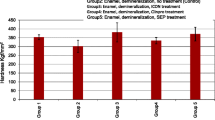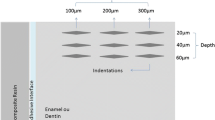Abstract
The aim of this study was to investigate margin integrity of Class V composite restorations in demineralized and sound enamel after bonding with different etch-and-rinse and self-etch adhesive systems. Out of a total of 60 specimens from bovine incisors, 30 specimens were demineralized (21 days, acid buffer, pH 4.95) to create artificial enamel lesions. Circular Class V cavities were prepared in all 60 specimens and treated with either an unfilled etch-and-rinse adhesive (Syntac Classic; Ivoclar Vivadent), a filled etch-and-rinse adhesive (Optibond FL; Kerr), or a self-etch adhesive (iBond Self Etch; Heraeus) (n = 10 per group). The cavities were restored with a nanofilled resin composite and thermocycled (5000×, 5–55 °C). Scanning electron microscopy was used to evaluate margin integrity of the composite restorations, and the percentage of continuous margin was statistically analyzed (α = 0.05). Demineralized enamel led to a significantly lower margin integrity when the self-etch adhesive iBond Self Etch was applied, but did not affect margin integrity when the etch-and-rinse adhesives Optibond FL (filled) or Syntac Classic (unfilled) were used. No significant differences in margin integrity in sound and demineralized enamel were observed between the different adhesives. Demineralized enamel reduces margin integrity of composite restorations when bonded with a self-etch adhesive, but does not affect margin integrity when an etch-and-rinse approach is used.






Similar content being viewed by others
References
Tauböck TT, Buchalla W, Hiltebrand U, Roos M, Krejci I, Attin T. Influence of the interaction of light- and self-polymerization on subsurface hardening of a dual-cured core build-up resin composite. Acta Odontol Scand. 2011;69:41–7.
Tauböck TT, Marovic D, Zeljezic D, Steingruber AD, Attin T, Tarle Z. Genotoxic potential of dental bulk-fill resin composites. Dent Mater. 2017;33:788–95.
Tauböck TT, Bortolotto T, Buchalla W, Attin T, Krejci I. Influence of light-curing protocols on polymerization shrinkage and shrinkage force of a dual-cured core build-up resin composite. Eur J Oral Sci. 2010;118:423–9.
Banerjee A, Pickard HM, Watson TF. Pickard’s manual of operative dentistry. 9th ed. Oxford: Oxford University Press; 2011.
De Almeida Neves A, Coutinho E, Cardoso MV, Lambrechts P, Van Meerbeek B. Current concepts and techniques for caries excavation and adhesion to residual dentin. J Adhes Dent. 2011;13:7–22.
Kielbassa AM, Ulrich I, Schmidl R, Schüller C, Frank W, Werth VD. Resin infiltration of deproteinised natural occlusal subsurface lesions improves initial quality of fissure sealing. Int J Oral Sci. 2017;9:117–24.
Tauböck TT, Zehnder M, Schweizer T, Stark WJ, Attin T, Mohn D. Functionalizing a dentin bonding resin to become bioactive. Dent Mater. 2014;30:868–75.
Körner P, El Gedaily M, Attin R, Wiedemeier DB, Attin T, Tauböck TT. Margin integrity of conservative composite restorations after resin infiltration of demineralized enamel. J Adhes Dent. 2017;19:483–9.
Peumans M, De Munck J, Van Landuyt KL, Poitevin A, Lambrechts P, Van Meerbeek B. A 13-year clinical evaluation of two three-step etch-and-rinse adhesives in non-carious class-V lesions. Clin Oral Investig. 2012;16:129–37.
Gamarra VSS, Borges GA, Júnior LHB, Spohr AM. Marginal adaptation and microleakage of a bulk-fill composite resin photopolymerized with different techniques. Odontology. 2018;106:56–63.
Sarr M, Kane AW, Vreven J, Mine A, Van Landuyt KL, Peumans M, Lambrechts P, Van Meerbeek B, De Munck J. Microtensile bond strength and interfacial characterization of 11 contemporary adhesives bonded to bur-cut dentin. Oper Dent. 2010;35:94–104.
Blunck U, Zaslansky P. Enamel margin integrity of Class I one-bottle all-in-one adhesives-based restorations. J Adhes Dent. 2011;13:23–9.
Bortolotto T, Doudou W, Kunzelmann KH, Krejci I. The competition between enamel and dentin adhesion within a cavity: an in vitro evaluation of class V restorations. Clin Oral Investig. 2012;16:1125–35.
Peumans M, Kanumilli P, De Munck J, Van Landuyt K, Lambrechts P, Van Meerbeek B. Clinical effectiveness of contemporary adhesives: a systematic review of current clinical trials. Dent Mater. 2005;21:864–81.
Buskes JA, Christoffersen J, Arends J. Lesion formation and lesion remineralization in enamel under constant composition conditions. A new technique with applications. Caries Res. 1985;19:490–6.
Magalhães AC, Moron BM, Comar LP, Wiegand A, Buchalla W, Buzalaf MA. Comparison of cross-sectional hardness and transverse microradiography of artificial carious enamel lesions induced by different demineralising solutions and gels. Caries Res. 2009;43:474–83.
Wiegand A, Stawarczyk B, Buchalla W, Tauböck TT, Özcan M, Attin T. Repair of silorane composite—using the same substrate or a methacrylate-based composite. Dent Mater. 2012;28:e19–25.
Ferrari R, Attin T, Wegehaupt FJ, Stawarczyk B, Tauböck TT. The effects of internal tooth bleaching regimens on composite-to-composite bond strength. J Am Dent Assoc. 2012;143:1324–31.
Bortolotto T, Betancourt F, Krejci I. Marginal integrity of resin composite restorations restored with PPD initiatorcontaining resin composite cured by QTH, monowave and polywave LED units. Dent Mater J. 2016;35:869–75.
Groddeck S, Attin T, Tauböck T. Effect of cavity contamination by blood and hemostatic agents on marginal adaptation of composite restorations. J Adhes Dent. 2017;19:259–64.
Frankenberger R, Hehn J, Hajtó J, Krämer N, Naumann M, Koch A, Roggendorf MJ. Effect of proximal box elevation with resin composite on marginal quality of ceramic inlays in vitro. Clin Oral Investig. 2013;17:177–83.
Maresca C, Pimenta LA, Heymann HO, Ziemiecki TL, Ritter AV. Effect of finishing instrumentation on the marginal integrity of resin-based composite restorations. J Esthet Restor Dent. 2010;22:104–12.
Ten Cate JM, Rempt HE. Comparison of the in vivo effect of a 0 and 1,500 ppmF MFP toothpaste on fluoride uptake, acid resistance and lesion remineralization. Caries Res. 1986;20:193–201.
Paris S, Hopfenmüller W, Meyer-Lueckel H. Resin infiltration of caries lesions: an efficacy randomized trial. J Dent Res. 2010;89:823–6.
Meyer-Lueckel H, Mueller J, Paris S, Hummel M, Kielbassa AM. The penetration of various adhesives into early enamel lesions in vitro. Schweiz Monatsschr Zahnmed. 2005;115:316–23.
Mueller J, Meyer-Lueckel H, Paris S, Hopfenmuller W, Kielbassa AM. Inhibition of lesion progression by the penetration of resins in vitro: influence of the application procedure. Oper Dent. 2006;31:338–45.
Paris S, Meyer-Lueckel H, Mueller J, Hummel M, Kielbassa AM. Progression of sealed initial bovine enamel lesions under demineralizing conditions in vitro. Caries Res. 2006;40:124–9.
Schmidlin PR, Sener B, Attin T, Wiegand A. Protection of sound enamel and artificial enamel lesions against demineralisation: caries infiltrant versus adhesive. J Dent. 2012;40:851–6.
Barcellos DC, Batista GR, Silva MA, Pleffken PR, Rangel PM, Fernandes VV, Di Nicoló R, Torres CR. Two-year clinical performance of self-etching adhesive systems in composite restorations of anterior teeth. Oper Dent. 2013;38:258–66.
Ermis RB, Van Landuyt KL, Cardoso MV, De Munck J, Van Meerbeek B, Peumans M. Clinical effectiveness of a one-step self-etch adhesive in non-carious cervical lesions at 2 years. Clin Oral Investig. 2012;16:889–97.
Frankenberger R, Tay FR. Self-etch vs etch-and-rinse adhesives: effect of thermo-mechanical fatigue loading on marginal quality of bonded resin composite restorations. Dent Mater. 2005;21:397–412.
Swanson TK, Feigal RJ, Tantbirojn D, Hodges JS. Effect of adhesive systems and bevel on enamel margin integrity in primary and permanent teeth. Pediatr Dent. 2008;30:134–40.
St-Pierre L, Chen L, Qian F, Vargas M. Effect of adhesive filler content on marginal adaptation of class II composite resin restorations. J Oper Esthet Dent. 2017;2:1–7.
Ramesh Kumar KR, Shanta Sundari KK, Venkatesan A, Chandrasekar S. Depth of resin penetration into enamel with 3 types of enamel conditioning methods: a confocal microscopic study. Am J Orthod Dentofac Orthop. 2011;140:479–85.
Meyer-Lueckel H, Paris S, Kielbassa AM. Surface layer erosion of natural caries lesions with phosphoric and hydrochloric acid gels in preparation for resin infiltration. Caries Res. 2007;41:223–30.
Grégoire G, Ahmed Y. Evaluation of the enamel etching capacity of six contemporary self-etching adhesives. J Dent. 2007;35:388–97.
De Munck J, Vargas M, Iracki J, Van Landuyt K, Poitevin A, Lambrechts P, Van Meerbeek B. One-day bonding effectiveness of new self-etch adhesives to bur-cut enamel and dentin. Oper Dent. 2005;30:39–49.
Souza-Junior EJ, Prieto LT, Araújo CT, Paulillo LA. Selective enamel etching: effect on marginal adaptation of self-etch LED-cured bond systems in aged Class I composite restorations. Oper Dent. 2012;37:195–204.
Taschner M, Nato F, Mazzoni A, Frankenberger R, Krämer N, Di Lenarda R, Petschelt A, Breschi L. Role of preliminary etching for one-step self-etch adhesives. Eur J Oral Sci. 2010;118:517–24.
De Munck J, Van Landuyt K, Peumans M, Poitevin A, Lambrechts P, Braem M, Van Meerbeek B. A critical review of the durability of adhesion to tooth tissue: methods and results. J Dent Res. 2005;84:118–32.
Loguercio AD, Luque-Martinez I, Muñoz MA, Szesz AL, Cuadros-Sánchez J, Reis A. A comprehensive laboratory screening of three-step etch-and-rinse adhesives. Oper Dent. 2014;39:652–62.
Schirrmeister JF, Huber K, Hellwig E, Hahn P. Two-year evaluation of a new nano-ceramic restorative material. Clin Oral Investig. 2006;10:181–6.
Schmidlin PR, Huber T, Göhring TN, Attin T, Bindl A. Effects of total and selective bonding on marginal adaptation and microleakage of Class I resin composite restorations in vitro. Oper Dent. 2008;33:629–35.
Author information
Authors and Affiliations
Corresponding author
Ethics declarations
Conflict of interest
The authors declare that they have no conflict of interest.
Rights and permissions
About this article
Cite this article
Körner, P., Sulejmani, A., Wiedemeier, D.B. et al. Demineralized enamel reduces margin integrity of self-etch, but not of etch-and-rinse bonded composite restorations. Odontology 107, 308–315 (2019). https://doi.org/10.1007/s10266-018-0398-6
Received:
Accepted:
Published:
Issue Date:
DOI: https://doi.org/10.1007/s10266-018-0398-6




